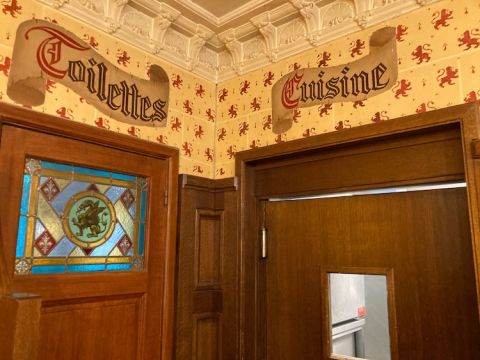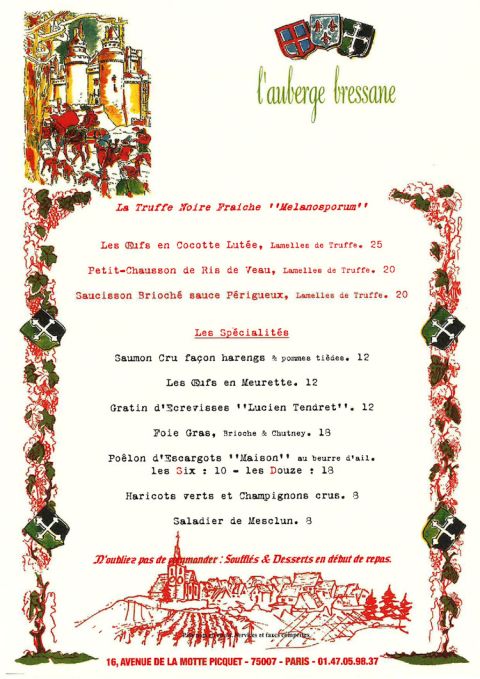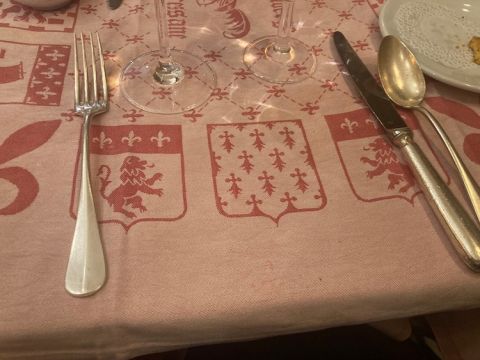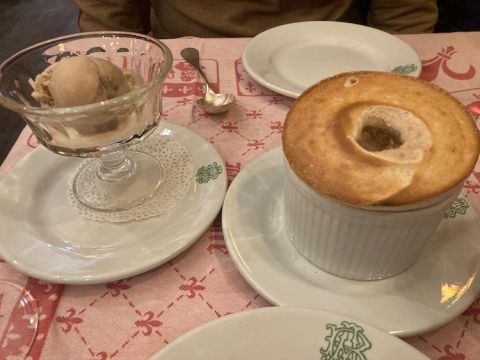If, as the saying goes, a picture is worth 1,000 words, let me start this review with a quick 3,000 words.
These photos reveal some of the interior, one of the menus and the place setting at L’Auberge Bressane, a Parisian brasserie in the 7th arrondissement, between Les Invalides and the Eiffel Tower, that has unquestionably stood the test of time.
Quite how long it has remained in this state, I have no idea. One writer I came across referred to it as having the characteristics of a Viollet-le-Duc reconstruction – the architect who inter alia preserved the walls of Carcassonne in faux aspic in the 19th century. I assume they meant that the restaurant looks almost like a pastiche of the sort of traditional Paris brasserie that has all but disappeared.
But it is convincingly all of a piece. The wallpaper, the signage, the tablecloths, the wall hangings, the chairs – they may all evoke a Paris, an auberge, that most of us thought was long gone. But L’Auberge Bressane is alive, thriving, serving pretty good food and wine and with an esprit that is friendly and charming.
How we ended up here is more complicated. Once the travel restrictions had been lifted, the prospect of a day trip to Paris with lunch as the primary attraction seemed very exciting. But then came the much harder decision of where to spend that time. Fortunately, a friend in hospitality from New York had been to Paris recently on a tour of its brasseries and came back with two new recommendations: d’Chez Eux and L’Auberge Bressane. The latter won, partly because of the attraction of its wine list and partly because the photos of the former were exclusively of men.
We arrived via a combination of modern transport. The Eurostar to the Gare du Nord, an RER train to St-Michel on the left bank, a 30-minute walk past the bouquinistes as they were busy setting out their stalls along the Seine, and then, because we were running late, a brief taxi ride. Stepping inside the front door of the restaurant was akin to stepping back to a Paris restaurant before the Second World War.
This restaurant’s layout resembles a train carriage. It is long and thin with a narrow passage down the centre with the all-important kitchen, and the toilettes, at the far end. The floorboards were extremely and, one imagines, proudly worn. All the tables and all the walls are covered in a red cloth pattern. The cutlery was old but extremely well polished and obviously very well used. Where there was not wallpaper there was a lot of wood on the walls, which also incorporated an old map, old signs, old-fashioned lamps and, hanging from a chain on the ceiling, an old clock.
All of which made us feel very welcome – although this could have been the warmth of the waiting staff. Under the stewardship of a smiling woman was a team of young men, each of them in a monogrammed white jacket. No hipster-wear here. They were each enthusiastic proponents of the restaurant – keen and eager. One, Asian, who served our main courses, said in pretty good English, ‘I hope you don’t mind if I speak English but I have to improve mine’ (this seemed to be very much a local not a tourist haunt).
That this is a restaurant which obviously wants to make its kitchen work comes across immediately. The à la carte menu is pretty extensive. The lunchtime menu offers a choice of four starters and four main courses, opening with ‘velouté Dubarry’, a cream of cauliflower soup, and also including ‘tête de veau, sauce ravigote’, two of my favourite brasserie dishes, good value for €35 including dessert.
Our Parisian friend arrived and we ordered. For some reason both he and Jancis chose from the day’s menu: scrambled eggs with grain mustard for her and the house terrine for him, followed by a piece of beef with bearnaise sauce. I went for the à la carte menu for several reasons. I was hungry (breakfast had been at 7.30 in St Pancras), it was our first such outing for a couple of years, and the à la carte seemed to be where the kitchen would be most likely to shine.
I chose two unusual dishes. The first, oeufs en cocottes with slivers of black truffles, was one of three dishes with this accompaniment, the others being sweetbreads or a brioche sausage, while the second was their pie of the day, which was described most enthusiastically by our young waiter. ‘It is a rich duck pie with plenty of foie gras and prunes.’ Such choices did mean saying goodbye to quenelles de brochet, a gratin of ecrivisses, côte de veau cooked in several different styles, and their renowned chicken à la creme with vin jaune and morels. For a return visit, may I hope.
Each course was good. The eggs were creamy, the black truffles nestling among them in the bottom of the bowl, which was capped with a crisp pastry topping that had been browned under a salamander. They are obviously well practised in the art of pastry-making as it was excellent pastry around my pie, which, once opened, revealed not just the duck and the foie gras but also a couple of stoned prunes and numerous redcurrants, which added bite and acidity to an extremely rich sauce that surrounded the pie.
Soufflés are another of this restaurant’s specialities: those containing truffles, Comté cheese and wild mushrooms are variously offered as a first course. But the list of those on offer for anyone with a sweet tooth is even more exciting: Grand Marnier, salted caramel, and chocolate are permanently on offer. But on the day we ate there the waiter mentioned that a chestnut soufflé was also available and this came with chestnut ice cream. One between the three of us seemed the perfect ending to a meal that was also distinguished by watching quite how liberal the waiter was with the bottle of Grand Marnier as he flambéed the crêpes for the table next to us.
We chose a bottle of Louis Michel, Montée de Tonnerre 2015 Chablis (€98), which was drinking well, and a fully mature Le Sang des Cailloux, Doucinello 2014 Vacqueyras (€59) from a list that has a strong leaning to Burgundy, feeling our main courses demanded something more robust.
I paid my bill of €300 and we sauntered out into the Parisian sunshine. I was only too aware that if I were a citizen of this city and I lived close to this beguiling restaurant, I would definitely become a regular and I would spend a great deal more here. I had managed to escape relatively inexpensively.
L’Auberge Bressane 16, Avenue de la Motte-Picquet, 75007 Paris, France; tel: +33 (0)1 47 05 98 37. Open for lunch and dinner every day except for Saturday lunch.



















